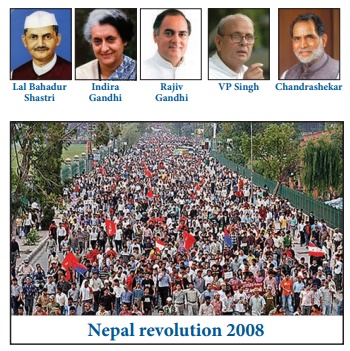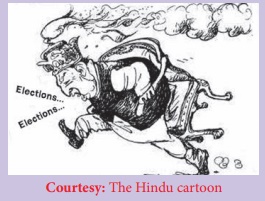Current Issues, Political, Cultural relations, Areas of Cooperation, Challenges - India - Nepal Relations | 12th Political Science : Chapter 10 : India and It’s Neighbours
Chapter: 12th Political Science : Chapter 10 : India and It’s Neighbours
India - Nepal Relations
India - Nepal Relations

India and Nepal are geographically close to each
other. Nepal’s lowland areas are a part of the Gangetic plain and it occupies
the central part of the Himalayan foothills and mountains that extends between
China and South Asia. Nepal and India share a border of over 1850 kms in the
East, South and West with five states, Sikkim, West Bengal, Bihar, Uttar
Pradesh and Uttarakhand sharing their borders. Nepal had been earlier the only
Hindu Kingdom in the world. However, one –eighth of its population are
Buddhists and there is a small population of Muslims and Christians living in
the country.
While Nehru always regarded Nepal as a sovereign
state, at the same time it was considered as an integral part of India’s
security system. Occupation of Tibet by China in 1951 affirmed Nepal’s
importance in India’s security umbrella. It was never a “threat from Nepal” but
“threat to Nepal”, that India could not afford. An important step towards
establishing such an order was the signing of Treaty of Peace and Friendship
between India and Nepal on July 31, 1950.
India’s overtures to Nepal went beyond the security
interest. On the same day of signing Peace and Friendship Treaty, both the
countries also signed Treaty of Trade and Commerce. This agreement became a
hallmark of close economic relations between both the countries.
Political Relations
India’s relations with Nepal in the immediate
aftermath of independence of both the countries revolved around the political
struggle between the King and the Rana’s, (Prime Ministerial clan of Nepal).
While negotiating the 1950 Treaty India was also persuading Nepal’s Rana rulers
to liberalize their political system to become more democratic and accommodate
a section of the population that was fighting to get political rights and
freedom. However, India’s advice did not seem to be making much impact on the
Ranas, which forced New Delhi to adapt proactive stance and intervene directly
in the Nepali situation
India’s approach to Nepal remained consistent ever
after the death of Nehru. The subsequent Prime Ministers Lal Bahadur Shastri,
Indira Gandhi, Rajiv Gandhi, VP Singh and Chandrashekar followed the same
policies for Nepal. There were numerous bilateral visits taken by Prime
Ministers of both countries to improve ties.

Post 1990’s India has been following a twin pillar
policy since restoration of the multi-party system. The pillars include
constitutional monarch and multi-party democracy sustaining together. But, this
policy started experiencing strains with the beginning of new millennium due to
two reasons, namely, the changing character of monarchy and the growing intensity
of the Maoist insurgency.
Nepal, the only South Asian country to
have never been formally colonized, is situated between India and China, two massive
competing economies, each with a unique historical relationship with the
Himalayan region.
Current Issues on India-Nepal Relations
Context
·
Nepal and China finalized the protocol of their
Transit and Transport deal.
·
Nepal declined to attend BIMSTEC military exercise
(MILEX 2018) hosted by India.
Brief background of relationship
·
India and Nepal share a very special relationship
with each other. They share a common culture and terrain south of the Himalaya.
Bound by languages and religions, marriage and mythology, the links of their
civilizational contacts run through both the countries.
·
At the people to people level, relations between
India and Nepal are closer and more multifaceted than between India and any
other country.
·
Republic of India and Nepal began their formal
relationship with the 1950 Indo-Nepal Treaty of Peace and Friendship. This
treaty is the cornerstone of our current relation with Nepal.
Significance of Nepal Strategic relations
·
Nepal’s geographical location is unique such that
it is a natural buffer between India and China.
·
Since Nepal is a landlocked country it greatly
depends on India for its interaction with the outside world.
Prime Minister Modi gave a new “5T”
(Tradition, Trade, Tourism, Technology and transport) formula for India-Nepal
relation during his visit in May, 2018.
Political relations
·
Nepal shares a special relationship with India
historically.
·
India has a treaty of peace and friendship with
Nepal since 1950.
·
This treaty is instrumental for a close cooperation
between the two countries.
·
India has always considered South Asia to be its
sphere of influence
Cultural relations
·
India and Nepal share a common culture and have a
long history of people to people relationship.
·
Nepali and Indian people visit each other’s country
for religious pilgrimage. Pashupati and Janakpur are traditional centres in
Nepal whereas Varanasi and the four Dhaams are important pilgrimage destination
in India.
·
The Buddhist network is interlinked -- Lumbini is
in Nepal, while Kushinagar, Gaya and Sarnath are in India.
·
It is said that India and Nepal have ‘Roti-Beti ka
Rishta’ (ties of food and family).
India-Nepal Treaty of Peace and Friendship-1950
The 1950 India-Nepal Treaty of Peace
and Friendship is a bilateral pact between the Government of Nepal and
Government of India aimed at establishing a close strategic relationship
between the two South Asian neighbours. The treaty was inked at Kathmandu on
July 31, 1950 by then Prime Minister of Nepal Mohan Shamsher Jang Bahadur Rana
and the then Indian ambassador to Nepal, Chadreshwar Narayan Singh. The treaty
permits free movement of people and goods between the two countries and a close
relationship and collaboration on matters of defence and foreign affairs.
Areas of Cooperation
1. Trade and Economic
·
India is Nepal’s largest trade partner and the
largest source of foreign investments, besides providing transit for almost the
entire trade which Nepal has with other countries.
2. Indian Investment in Nepal
·
Indian firms are the leading investors in Nepal,
accounting for about 40% of the total approved foreign direct investments.
3. Water Resources and energy cooperation
·
A three–tier mechanism established in 2008, to discuss
all bilateral issues relating to cooperation in water resources and hydropower.
·
Nepal has many fast flowing rivers and its terrain
makes it ideal for hydroelectric power generation. Nepal’s installed capacity
is less than 700 MW while it has a potential to generate over 80,000 MW.
·
A 900 megawatts hydropower project Arun III has
been launched recently.
·
An Agreement on “Electric Power Trade, Cross-border
Transmission Interconnection and Grid Connectivity” was signed between India
and Nepal in 2014.
·
A Joint Technical Team (JTT) has been formed for
preparation of long-term integrated transmission plan covering projects up to 2035.
4. Defense Cooperation
·
The Gorkha Regiments of the Indian Army are raised
partly by recruitment from hill districts of Nepal.
·
Since 1950, India and Nepal have been awarding Army
Chiefs of each other with the honorary rank of General.
·
Bilateral defense cooperation includes assistance to
Nepal Army in its modernization through provision of equipment and training.
·
About 250 training slots are provided every year
for training of Nepal Army personnel in various Indian Army Training
institutions.
·
India and Nepal conducted a joint military
exercise, Surya Kiran XIII from May 30 to June 12 in Uttarakhand this year.
5. Infrastructure and connectivity
·
Recently a MoU was signed on Raxaul-Kathmandu railway
line. A postal highway project is also being undertaken.
·
Both the countries are also focused on inland
waterways connectivity.
6. People to People cooperation
·
The Governments of India and Nepal have signed
three sister-city agreements for twinning of Kathmandu-Varanasi,
Lumbini-Bodhgaya and Janakpur-Ayodhya.
·
Direct bus service between Janakpur and Ayodhya
under Ramayan Circuit under Swadesh Darshan Scheme was launched.
·
Nepal and India share Hindu and Buddhist heritage.
Lumbini, the birth place of Lord Buddha is in Nepal while Bodh Gaya where he
attained enlightenment is in India. Similarly the hindu pilgrimage places are also
spread in both countries.
Activity

Give two reasons
why King Gyanendra refused to accept the transition from a feudal autocracy and
monarch to a democratic republic.
Challenges
1. Border issues:
·
The two major areas of dispute at Susta and
Kalapani (India-China-Nepal tri-junction).
·
Countries agreed to start talks at the foreign
secretary-level in order to resolve the problem, however, only a single round
of talk has taken place in 2015.
2. Internal Security
·
There is an open border between India and Nepal
which leads to illegal migration and human trafficking.
· Indo-Nepal border is used as launch pad by maoist, terrorist and drug traffickers.
3. Trade
·
Nepal’s trade deficit with India has surged in
recent years with continuously rising imports and sluggish exports.
· Indo-Nepal trade continues to remain massively in India’s favor.
4. Peace and Friendship Treaty
·
The India-Nepal Treaty of 1950 has been criticized
by the Nepali political elite as an unequal one.
·
Treaty obliged Nepal to inform India and seek its
consent for the purchases of military hardware from third countries. Nepal
wants to change this provision.
· The Nepal-India Eminent Persons’ Group (EPG) is revisiting all bilateral agreements to submit a comprehensive report to both governments on how to reset bilateral relations.
5. Nepal’s growing proximity to China
·
Nepal’s attempt to balance the overwhelming
presence of India next door by reaching out to China is resented by India as
such actions heighten India’s security concerns.
·
Chinese are building a number of highways from the
Tibetan side into Nepal, all the way down to East-West highway that traverses
Nepal.
·
China plans to extend the Tibet railway to Kathmandu
across the border in the next few years.
·
Nepal signed the Belt and Road Initiative (BRI)
Framework agreement with China last year.
·
China is trying to contest Indian interests by
cultivating local interest groups that could advance China’s interests in
Nepal.

Transit and Transport deal
·
Nepal and China finalized the Protocol of Transit and Transport deal. As per the
agreement Nepal can access four ports and three dry ports paving way for the
use of Chinese ports for trade. This will reduce Nepal’s dependency on India
for its trade.
·
These and other road and railway projects between
China and Nepal will allow China to potentially project power against India on
a different section of the Sino-Indian boundary.
Why China cannot replace India vis-a-vis Nepal?
·
India has an advantage of geography on its side.
Chinese rail and port connectivity projects are not very feasible owing to the
difficult terrain.
·
The nearest Chinese ports will be close to 3000 km
away while Kolkata and Visakhapatnam ports, which Nepal currently uses are much
more closer.
Related Topics